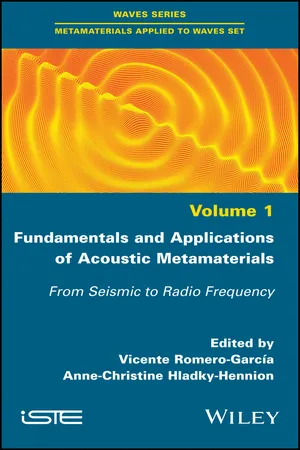
Fundamentals and Applications of Acoustic Metamaterials
From Seismic to Radio Frequency
- English
- ePUB (mobile friendly)
- Available on iOS & Android
Fundamentals and Applications of Acoustic Metamaterials
From Seismic to Radio Frequency
About this book
In the last few decades, metamaterials have revolutionized the ways in which waves are controlled, and applied in physics and practical situations. The extraordinary properties of metamaterials, such as their locally resonant structure with deep subwavelength band gaps and their ranges of frequency where propagation is impossible, have opened the way to a host of applications that were previously unavailable. Acoustic metamaterials have been able to replace traditional treatments in several sectors, due to their better performance in targeted and tunable frequency ranges with strongly reduced dimensions. This is a training book composed of nine chapters written by experts in the field, giving a broad overview of acoustic metamaterials and their uses. The book is divided into three parts, covering the state-of-the-art, the fundamentals and the real-life applications of acoustic metamaterials.
Frequently asked questions
- Essential is ideal for learners and professionals who enjoy exploring a wide range of subjects. Access the Essential Library with 800,000+ trusted titles and best-sellers across business, personal growth, and the humanities. Includes unlimited reading time and Standard Read Aloud voice.
- Complete: Perfect for advanced learners and researchers needing full, unrestricted access. Unlock 1.4M+ books across hundreds of subjects, including academic and specialized titles. The Complete Plan also includes advanced features like Premium Read Aloud and Research Assistant.
Please note we cannot support devices running on iOS 13 and Android 7 or earlier. Learn more about using the app.
Information
PART 1
Overview of the Current Research in Acoustic Metamaterials
1
Visco-thermal Effects in Acoustic Metamaterials Based on Local Resonances
1.1. Introduction
Table of contents
- Cover
- Table of Contents
- Preface
- PART 1: Overview of the Current Research in Acoustic Metamaterials
- PART 2: Principles and Fundamentals of Acoustic Metamaterials
- PART 3: Applications of Acoustic Metamaterials
- Appendices
- List of Authors
- Index
- End User License Agreement